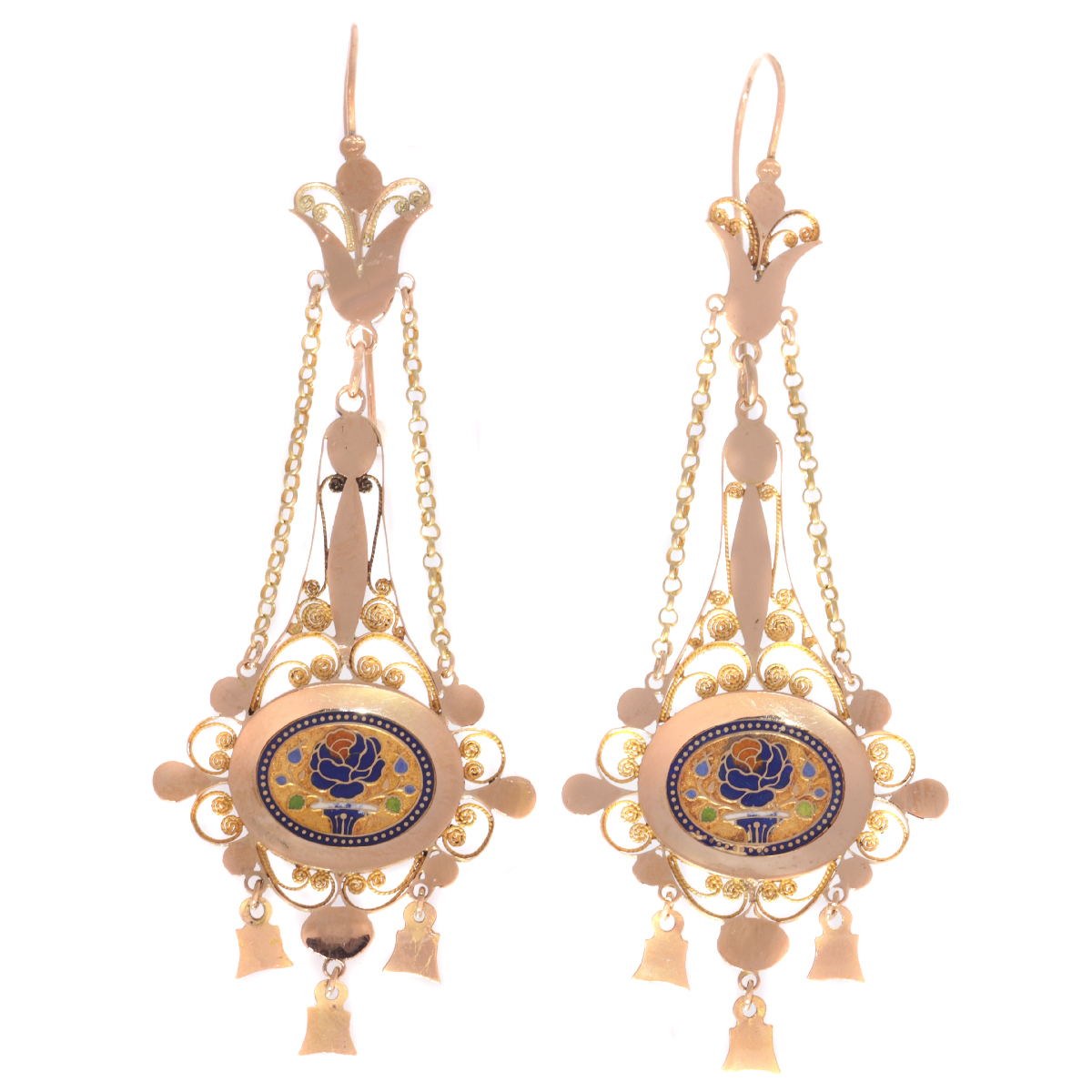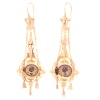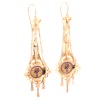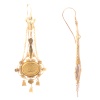Nu gespreide betaling mogelijk op het juweel van uw dromen! Vraag ons naar de details.
Gratis verzekerde verzending van alle orders!
Antique gold pendent earrings with filigree and enamel early 19th Century
Antique jewelry object group: earrings long hanging
Condition: excellent condition
- (more info on our condition scale)
Country of origin:
"The Southern Netherlands" the former name for the current Belgium. (Belgium seceded from the Netherlands in 1831.)
Style: Pre-Victorian -
- See also: Pre-Victorian
or more info on styles
Style specifics:
A style that borrowed style specifics from the ancient Greeks and the Roman empire (hence the name of the style: Empire). The empire period represents the second part of the Neo-Classical style, and shows a strong French influence. The style originated
in the desire of Napoleon to revive the luxurious majesty of imperial Rome. Traditional classical motifs, already seen in the reign of Louis XVI, were supplemented by symbols of imperial grandeur- the emperor's monogram and his emblem, the bee;
representations of military trophies; and after the successful campaigns in Egypt, Egyptian motifs. If we had to characterize this style briefly, we could focus on two elementary concepts: massiveness and symmetry.
Period: ca. 1820
- (events & facts of this era, poetry of this era,
fashion of this era)
Source of inspiration: Mother Nature (see also: flower symbolism)
Theme: The Rose - First of all a symbol of love but there are many prophecies, legends and fairy tales made about this beautiful flower.
A rose that blooms in autumn can mean a marriage. And you must remember the fairy tail of Sleeping Beauty. The bad queen pricked the beautiful, young princess with a thorn from a rose. She slept 100 years and a beautiful, young prince woke her up with a
kiss. They married and they lived happily ever after. There exists a legend about how the rose got her thorns. The rose grew originally in the Garden of Eden and had no thorns. After the fall the rose got her thorns to remind people of their sin. Her
beauty might been kept as memory of Paradise.
In the antiquity Eros, the Greek God of Love, was represented as a fresh and rosy (color of roses), lively and cheerful boy with goldish hair (like the stamens). The arrows were like the thorns and his wings were like the petals of the rose. In beauty,
shape and scent, the rose is outstanding and hence has become the most commonly used floral symbol in the West. Roses have symbolical meanings in classic and Christian art. For example Venus was associated with roses, symbolizing love and beauty, whereas
Virgin Mary sometimes was called a « rose without thorns » because of her purity.
Material: 18K bi-color (yellow and red) gold
- (more info on precious metals)
Technique (01):
Enamelling is an old and widely-adopted technology. The ancient Egyptians applied enamels to pottery and stone objects. The ancient Greeks, Celts, Russians, and Chinese also used enameling processes on metal objects. Enamel is the colorful result of
fusing powdered glass to a substrate by firing, usually between 750 and 850 degrees Celsius. The powder melts and flows and hardens to a smooth, durable vitreous coating on metal, glass or ceramic. According to some sources, the word enamel comes from
the High German word smelzan (to smelt) via the Old French esmail. Used as a noun, "an enamel" is a usually small decorative object, coated with enamel coating, such as a champlevé or a cloisonné (different techniques).
Technique (02):
Filigree (formerly written filigrann or filigrane) is a delicate kind of jewel work made with twisted threads usually of gold and silver or stitching of the same curving motifs. It often suggests lace and French from 1660 to the late 19th century. It
should not be confused with ajoure jewellery work; while both have many open areas, filigree involves threads being soldered together to form an object and ajoure involves holes being punched, drilled, or cut through an existing piece of metal. (from: Wikipedia)
Hallmarks: The hallmark found (the cornucopia or horn of plenty) in this jewel was used in the former Southern Netherlands (now Belgium) between 1815 and 1832.
- (more info on hallmarks)
Dimensions: height 7,15 cm (2,81 inch)
Weight: 3,90 gram (2,51 dwt)
Reference Nº: 19212-0023
Copyright photography: Adin, fine antique jewelry
jewelry with rose motif,
all floral jewelry,
jewelry with enamel,
jewelry with filigree & granules,
red gold jewelry,
yellow gold jewelry,
bi-color jewelry,
latest acquisitions,
antique jewelry,
estate jewelry,
vintage jewelry or
modern jewelry
Jewelry with birthstones (or month stones) for:
January -
February -
March -
April -
May -
June -
July
August -
September -
October -
November or
December.
Additional information:
jewelry glossary -
wall of fame -
visit us in Antwerp -
subscribe to our mailinglist.
What is antique jewelry? -
What is estate jewelry? -
What is vintage jewelry?









